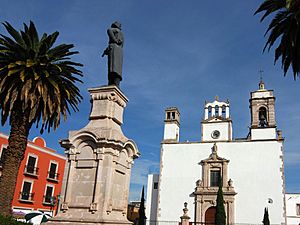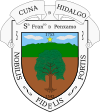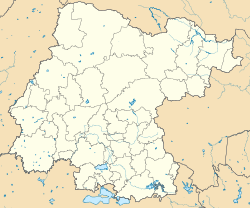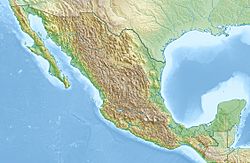Pénjamo facts for kids
Quick facts for kids
Pénjamo, Guanajuato
|
||
|---|---|---|

Monument to Hidalgo and San Francisco temple in the main square of Pénjamo
|
||
|
||
| Nickname(s):
Cuna de Hidalgo
|
||
| Country | Mexico | |
| Federal entity | Guanajuato | |
| Founded | 12 November 1542 | |
| Elevation | 1,770 m (5,807 ft) | |
| Population
(2000)
|
||
| • Total | 40,076 | |
| Time zone | UTC-6 (Central Standard Time) | |
| • Summer (DST) | UTC-5 (Central Daylight Time) | |
Pénjamo is a city in Guanajuato, Mexico. Its name means 'place of ahuehuetes or sabinos' in an old language. It is also known as the 'Cradle of Hidalgo'. This is because Miguel Hidalgo y Costilla, a very important person in Mexican history, was born nearby.
Pénjamo was founded around 1549 by native groups like the Guamares, Purépechas, and Otomis. The city is located in the southwest part of Guanajuato state. It covers a large area of land. Pénjamo borders other towns in Guanajuato, as well as the states of Jalisco and Michoacán. In 2010, the city had about 41,000 people. Most people work in services, trade, and tourism.
Pénjamo is part of a larger area called the Pénjamo-La Piedad Metropolitan Zone. This zone includes parts of Guanajuato and Michoacán. It has over 229,000 people. The town of Santa Ana Pacueco, which is part of Pénjamo, is very close to La Piedad, Michoacán. They are only separated by the Lerma River and connected by seven bridges. This means the two cities share many needs and work together.
Contents
Exploring Pénjamo's Geography
Pénjamo city is located at 101° 42' 22" west longitude and 20° 25' 44" north latitude. It is about 1,700 meters (5,577 feet) above sea level. Some parts, like Pénjamo's Mountains, are even higher, reaching 2,400 meters (7,874 feet).
You can reach the city using federal road 90. This road connects Irapuato city with Guadalajara city. Pénjamo is about 40 minutes away from Irapuato.
Much of Pénjamo is built on the slopes of the Pénjamo Mountains. The city center is on hilly land. Other parts are on hills or flat areas. This is why some streets in Pénjamo are very steep, while others are flat.
Pénjamo's Rich History
The land where Pénjamo is today was first home to the Guachichil and Purépecha groups. You can see their ancient cultures at the Plazuelas Archaeological Zone. This is the most important archaeological site in the state.
The city was officially founded on November 12, 1542. It was named San Francisco de Penxamo. The name Penlamu, meaning "place of sabinos or ahuehuetes," comes from the Tarascan language. King Carlos V of Spain allowed Captain Diego Tomás de Jesuchihua to establish the city.
Birthplace of a National Hero
On May 8, 1753, Miguel Hidalgo y Costilla was born near Pénjamo. He is known as the Father of the Mexican Nation. He was born at the Corralejo Hacienda, which is now called Corralejo Hidalgo.
Pénjamo in the War of Independence
Pénjamo played a role in the Mexican War of Independence. The Spanish fighter Francisco Javier Mina was shot in the Pénjamo Mountains. Another rebel leader, Albino García, fought against royalist forces in Pénjamo in August 1811. They attacked the city to get supplies.
In 1815, the city was badly damaged by fire and almost completely destroyed. Rebuilding began around 1830.
Growing into a City
On May 22, 1857, Pénjamo became a 'villa' (a town with special rights). Then, in 1906, it was officially made a 'city' by Governor Joaquín Obregón Gonzalez. Today, Pénjamo has about 40,000 residents.
The most important historical fact about Pénjamo is that Miguel Hidalgo, the Father of the Mexican Nation, was born here in 1753. The Pénjamo area was also where Francisco Xavier Mina fought battles during the War of Independence. He was shot in the Pénjamo Mountains.
During World War II, when Mexico joined the war, the city's lights were turned off at night. This was done to prevent possible bombings.
The City's Special Seal
The official seal of Pénjamo has a picture of an Ahuehuete tree. Below the tree, you can see the year the city was founded, 1542. Underneath that is a drawing of the Cerro Grande (Grand Hill) with a blue sky and a golden star. Below the star is the year Miguel Hidalgo was born, 1753.
At the top of the shield, it says 'Cradle of Hidalgo, San Francisco de Penxamo'. Around the shield, there is a Latin motto: Nobilis, Fidilis, Fortis. This means 'noble, faithful, strong'.
Modern Changes and Progress
The local, state, and national governments understand how important tourism is for Pénjamo. They have worked to improve the city's historic center and promote the archaeological zone. Shops and other buildings have been improved, making many parts of the city more modern.
Efforts have also been made to improve the city's appearance and protect its natural areas. The old Corralejo Hacienda has become a popular tourist spot. Thousands of visitors come to see where Miguel Hidalgo was born or to try local tequilas. The city has made great progress, even though there is still more to do.
Pénjamo's roads and streets have improved a lot. New avenues and boulevards have been built. The city's new bus station also makes a better impression on residents and visitors.
Education and Healthcare
Pénjamo has two public universities:
- UNIDEG (Interactive and Distance University of Guanajuato, Pénjamo Campus)
- UPG or UPP (Technical University of Guanajuato, Pénjamo Campus)
The UPG is considered the top university in the city and one of the best in the region. There are also several high schools, like CECyTEG and CONALEP. The University of Guanajuato also has a presence in the city, offering preparatory courses.
For healthcare, Pénjamo has excellent hospitals. These include the Regional Hospital of the Southwest, an ISSSTE clinic, an IMSS clinic, and a Community Hospital. There are also many private hospitals.
Plans are underway to build a heliport and a public safety command center for the Southwest region.
Public Spaces and Commerce
Pénjamo has many public spaces for recreation. These include squares, gardens, parks, and sports facilities throughout the city. More are being built.
The city has also attracted large self-service stores and national clothing and footwear stores. This helps boost trade and offers more attractions for both visitors and residents.
Pénjamo now has two TV channels. One broadcasts 24 hours a day, and the other broadcasts for a few hours.
The city is part of the Pénjamo-La Piedad Metropolitan Zone. This is expected to bring many new investments to the area.
Fun Tourist Attractions
Pénjamo itself is a great place to visit! It has many shops, restaurants, coffee shops, parks, and beautiful churches. Buildings like the main market and Catholic temples are true architectural gems. These include the Parish of Saint Francis of Assisi, the Parish of Our Lady of Los Remedios, and the Temple of San Antonio of Padua. You can also visit the Municipal Palace and the House of Culture.
The city is surrounded by green areas like Magellan and Churipitzeo. Pénjamo offers many places to stay, fitting different budgets. The city is part of "Route 2010." This route connects cities that were important during Mexico's Independence War and Revolution.
- Corralejo: This is the birthplace of Don Miguel Hidalgo y Costilla, the Father of the Nation. The old estate and its monuments are wonderful to visit. You can enjoy traditional celebrations during the first week of May, celebrating Hidalgo's birthday.
- Plazuelas: This is an important archaeological zone. During spring, you can see pre-Hispanic dances and events near the pyramids. There's also a museum with artifacts found at the site. It's a great place for a weekend trip. A clean blue river flows nearby. Remember to respect nature and keep the area clean. There's a paved road to the pyramids, parking, and guides. On weekends, you can buy local food, souvenirs, and crafts.
- Pénjamo's Mountains: This is a natural area that might become a protected zone. It has amazing canyons, mountains, and hills. This area was important during Mexico's history. The rebel Francisco Javier Mina was shot here. The mountains spread across several towns, but mostly Pénjamo. You can find old ruins, a clear river, and impressive rocks. It's perfect for extreme sports and camping.
- The May Fair: Also known as the "Holidays of May," this fair takes place from late April to early May each year. Many national and international artists perform for free. There are commercial and livestock exhibitions, plus events like "jaripeos" (Mexican rodeos) and bullfighting shows. Other celebrations happen in Santa Ana and Corralejo. The main event is on May 8th, celebrating Miguel Hidalgo's birthday, with local and national leaders attending.
- Cultural Week of the Foundation: This event lasts several days, from November 6th to 13th. It celebrates the city's founding on November 12, 1542. During this week, you can see photo exhibits, old vehicles, theater, and music. There's a parade on the 12th, fireworks at night, motocross shows, international artistic performances, and "jaripeos."
Famous People from Pénjamo
- Don Miguel Hidalgo y Costilla: Born in 1753 at the Corralejo Estate near Pénjamo. He is known as the Liberator of Mexico and the Father of the Nation. His parents were Ana Maria Gallaga and Cristobal Hidalgo. His father managed the Corralejo Hacienda, so Miguel Hidalgo was not born into poverty. In 1810, he started the fight for independence and ended slavery. This event is called the "Cry of Dolores." Hidalgo's independence campaign lasted until 1811. He was captured and shot in Chihuahua. His head was displayed for years at the Granaditas Public Granary in Guanajuato. After Mexico won independence in 1821, Hidalgo's remains, along with other heroes, were moved to the Independence Column in Mexico City in 1910. They rest there today.
- Joaquín Pardavé: A famous film and theater director, composer, and actor. He was born in Pénjamo in 1900. Even though he worked mostly in Mexico City, he loved to return to his hometown. He even wrote a famous song called "Pénjamo" about his city. A municipal hall, a main avenue, and a lounge at a famous tequila company in Pénjamo are named after him.
- Francisco Javier Mina: An insurgent leader known as "El Mozo." He was shot in the Fort of the Remedios, which is part of the Pénjamo Mountains, during the War of Independence.
- Antonio Gómez Rodríguez: The creator of the National Shield of Mexico. He lived in Pénjamo, and some believe he designed the shield there.
- Luis Navarro Origel: An important participant in the "Cristeros" social war in Mexico during the 1920s. He was born in Pénjamo and also served as the city's mayor.
- Ignacio Vázquez Torres: A lawyer and politician. He was a member of the PRI political party and served as a deputy (representative) many times.
See also
 In Spanish: Pénjamo para niños
In Spanish: Pénjamo para niños




